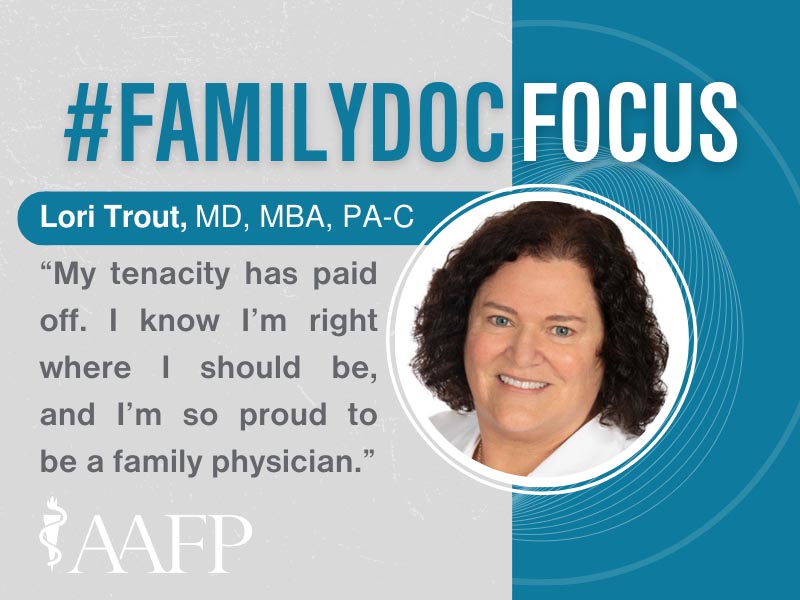Third-year Resident Realizing Dream Deferred for Decades
Nov. 14, 2023, David Mitchell — In a career spanning more than 20 years, Lori Trout, M.D., M.B.A., PA-C, has already worked as a hospitalist, emergency room clinician, medical school faculty and primary care clinician for an entire community.

Next spring she will add “family physician” to her curriculum vitae.
“I just never stopped believing in that dream,” said Trout, a third-year resident at the Lewistown Rural Family Medicine Residency Program in Pennsylvania.
Trout started a family while she was in college and studied to become a physician assistant at the University of Texas Medical Branch. She worked as a PA to pay for medical school, but she got divorced halfway through her studies at the University of Health Sciences Antigua School of Medicine.
Trout finished her medical degree in 2002, but as a single parent she thought it would be impossible to pay all the travel and childcare expenses associated with the residency interview process and take a pay cut as a resident.
“I literally could not afford it,” she said, “so I had to continue working as a PA until my kids were raised.”
Trout worked at a Texas medical center for three years, then as a clinician and faculty at her alma mater, UTMB, for two. When her second husband took a job in the Netherlands Antilles, Trout worked as an associate professor of clinical medicine for a Caribbean medical school for three years.
An ever greater and more distant adventure awaited. For six years, Trout was a clinic director (and sole clinician) for a small village of 400 people on an Alaskan island.
“Alaska was fabulous,” she said. “My supervising physician was quite a ways away by plane or by ferry. I was on call 24/7. I had virtually no equipment. I had an X-ray machine and an EKG. The only tests I could do were glucose, pregnancy, INR and strep. I couldn’t do any cardiac labs. I couldn’t do a CBC or electrolytes. You had to use your brain and your stethoscope to figure things out. If you just stick to the basics of medicine, you can figure out if someone can stay in your village or if you need to call the Coast Guard to ship them out.”
Trout said she developed excellent communication skills, talking to patients and families when emergent care needs collided with harsh Alaskan weather conditions.
“There are some circumstances that you have to make a decision, if the weather is bad, whether or not it’s appropriate to ask a crew to fly in,” she said. “It takes about three hours to get a crew to that island and then another hour and a half to get the patient to a place where there’s a hospital. That can be done in good weather or bad, but you really have to talk to the patient and the patient’s family before calling in a crew in really bad weather. You may have six souls on board that aircraft. Are you asking them to pick up someone who could wait until the weather clears?”
Trout returned to the lower 48 states in 2016, working as a PA in emergency medicine at the University of Pittsburgh Medical Center in Altoona. She still dreamed of being a family doctor, but she had been out of medical school for more than a decade. In the Electronic Residency Application Service, programs can filter their searches for potential residents by medical school graduation year, which meant Trout wasn’t likely to be found unless someone gave them a reason to look for her specifically.
“The physician director of the ER called some places, made contact with the program directors and basically said, ‘I have a really good PA here who has a medical degree and deserves to be a doctor,’” she said. “And then people manually pulled my applications and read them and felt like it was worth giving me a try for an interview.”
Trout, who was one of 12 residents recognized with the AAFP’s Award for Excellence in Graduate Medical Education last month during the Family Medicine Experience in Chicago, found her match in Lewistown. She already has a job waiting at a primary care clinic in Altoona after graduation.
“I’m still staying rural, and I will do everything from newborn babies to geriatrics,” she said. “I plan on doing in-office procedures.”
Trout grew up in a small town and is eager to start her family medicine practice in a similar setting.
“One of the things that I loved in Alaska was when patients came in with a sack of shrimp or half of a halibut,” she said. “Here in the rural program I’m in, we do a lot of home visits to the Amish and to the elderly. I like doing home visits. I like knowing about patients’ families. I like that continuity of care. My plan is just plain, rural family medicine, taking care of sick people, sending them to the hospital when they need to go, and keeping them out of the hospital as much as possible. My tenacity has paid off. I know I’m right where I should be, and I’m so proud to be a family physician.”